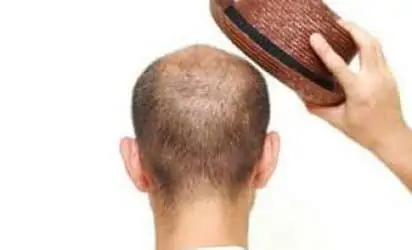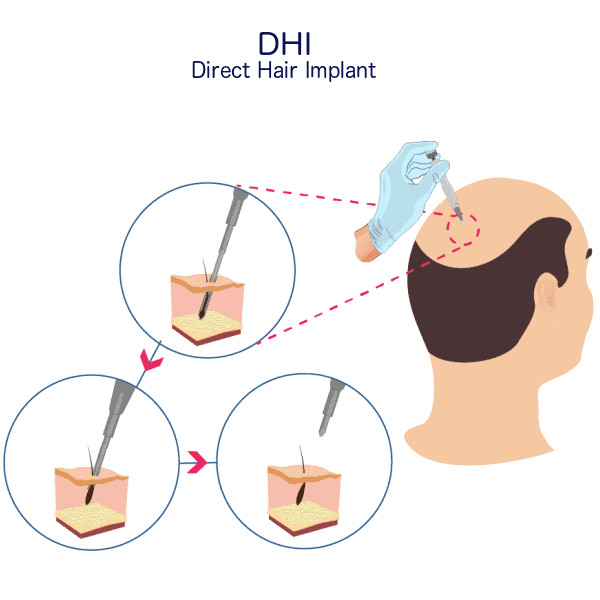 DHI Hair Transplant, also known as Direct Hair Implantation, is one of the most advanced and minimally invasive hair restoration techniques available today. Unlike traditional hair transplant methods, DHI offers natural-looking results without the need for surgical incisions or stitches, making it an ideal solution for those seeking a quicker recovery and virtually scar-free treatment.
DHI Hair Transplant, also known as Direct Hair Implantation, is one of the most advanced and minimally invasive hair restoration techniques available today. Unlike traditional hair transplant methods, DHI offers natural-looking results without the need for surgical incisions or stitches, making it an ideal solution for those seeking a quicker recovery and virtually scar-free treatment.
What Is DHI Hair Transplant?
DHI Hair Transplant is a modern technique where individual hair follicles (called grafts) are extracted from the donor area and directly implanted into the recipient area using a specialized implanter pen, commonly known as the Choi Pen. This method eliminates the need to open channels before implantation, which is a key difference from other techniques such as FUE (Follicular Unit Extraction).
In DHI, the time between extraction and implantation is minimized, significantly reducing the grafts’ exposure to air. This helps maintain the health and viability of hair follicles, leading to better survival rates and more successful outcomes.
How Is DHI Hair Transplant Performed?
The DHI process involves several steps. First, using a micro punch device, hair follicles are gently extracted from the donor area, usually the back of the scalp. Then, the follicles are loaded into a Choi implanter pen and directly inserted into the recipient area without needing to create incisions beforehand. The procedure is performed under local anesthesia for a pain-free experience. Each follicle is implanted at a precise angle, depth, and direction to ensure a natural hair growth pattern.
Since every graft is handled individually, the procedure may be divided into multiple sessions to achieve optimal density and results.
Advantages of DHI Hair Transplant
DHI Hair Transplant offers a range of advantages over traditional methods. First and foremost, it allows for a highly natural appearance, as each hair follicle is implanted at a specific angle and direction. The lack of incisions or stitches ensures that there are no visible scars and that healing occurs faster.
This technique also significantly reduces bleeding and infection risk due to its minimally invasive nature. One of the key benefits is that DHI does not require shaving the entire head, making it especially suitable for women or patients who prefer to maintain their current hairstyle.
Another benefit is that the hair follicles are implanted immediately after extraction, which minimizes their exposure to air and improves the overall survival rate. As a result, the final outcome tends to be fuller, denser, and more natural-looking hair.
Who Is a Good Candidate for DHI?
DHI Hair Transplant is suitable for men and women experiencing localized or early-stage hair loss. It is also ideal for those who desire high hair density and want a minimally invasive procedure with faster healing. However, the best way to determine whether you’re a good candidate is by consulting with a specialist who can evaluate your hair condition, medical history, and expectations.
 DHI vs. FUE Hair Transplant: What’s the Difference?
DHI vs. FUE Hair Transplant: What’s the Difference?
While both DHI and FUE techniques are effective and widely used, there are several important differences. In the DHI method, hair follicles are implanted directly into the recipient area using a Choi Pen, without the need for creating channels beforehand. This results in less trauma to the scalp and often faster recovery. Also, in DHI, the grafts are not stored for long periods, which increases their survival rate.
FUE, on the other hand, involves extracting hair follicles and storing them temporarily before creating incisions in the recipient area to implant them. While FUE also provides natural results, the recovery time may be slightly longer, and the precision in graft placement is generally not as high as in DHI.
DHI is particularly suited for patients who do not want to shave their hair and who prefer a denser, more controlled implantation process.
Is DHI Hair Transplant Permanent?
Yes, DHI Hair Transplant offers permanent results. The hair follicles used in the procedure are usually taken from the back or sides of the scalp, areas that are genetically resistant to hair loss. Once implanted, these follicles continue to grow like natural hair for a lifetime.
Post-Procedure Recovery and Care
After a DHI Hair Transplant, mild redness and swelling may appear, but these typically subside within a few days. Most patients can return to their daily routine in just 1-2 days. Temporary hair shedding, also known as “shock loss,” may occur within two weeks, which is a normal part of the process.
New hair growth usually begins around the third month and continues to improve over the following 6 to 12 months. To support recovery and growth, clinics often recommend specialized shampoos, topical treatments, and PRP therapy.
How Much Does DHI Hair Transplant Cost?
The cost of a DHI Hair Transplant varies depending on several factors, such as the number of grafts needed, the expertise of the surgeon, the location and reputation of the clinic, and whether additional services (like PRP, exosome therapy, or hotel accommodations) are included.
Due to regulations set by the Turkish Ministry of Health, clinics are not allowed to display prices on their websites. For updated and personalized pricing, please call our clinic at +90 212 241 46 24.
Why Choose Our Clinic for DHI Hair Transplant in Turkey?
- Specialists performing only DHI technique
- No shaving, no pain — thanks to local anesthesia
- Maximum grafts in one session
- Painless anesthesia with fast healing
- One-year follow-up support
- All-inclusive packages with hotel, transfers, medication, shampoo, and surgical hair wash

